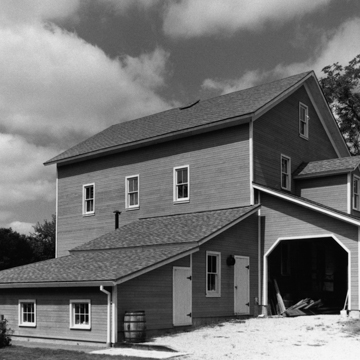The Beckman Mill, now a museum, reminds us that rural industry once relied on the power of running water. Gristmills and sawmills dotted the landscape, putting the energy of rivers and streams to work. This is one of the few survivors. The milldam and millpond on Raccoon Creek date from the 1840s, but the mill itself did not begin its activity until 1868, when millwright William Howe purchased the site at a sheriff’s auction and built a gristmill, apparently on the ruins of an old distillery. Catherine Beckmann acquired the property in 1882. Her husband, August, and later their sons operated the mill continuously until 1954, grinding buckwheat, oats, wheat, rye, and barley. “Newark Mills,” as the Beckmans called their business, also became the hub of this rural community, a pattern for gristmills across the country. The mill is a three-story utilitarian building with a front-gabled roof and two-over-two windows. Howe constructed it with board-and-batten siding, but in 1924 the Beckman brothers (as they then spelled their name) remodeled the mill with clapboard siding, scored to make the boards appear narrower than they are. They added a shed-roofed addition to the south, housing an auxiliary power source and a storage area, and a lean-to drive-through at the front, sheltering the loading dock.
The mill is operational. Water rushes out of the adjacent millpond (whose restored dam has an added fish ladder to protect endangered fish), through a flume, and into a turbine pit under the basement at the rear of the building. There, the flow turns two horizontal turbines: a larger 150-horsepower turbine that powers the left set of grinding stones and a smaller 75-horsepower machine that powers the right. The drive shafts of these turbines rise through the three floors of the building, connecting with cogs and gears to power the millstones. James Leffel and Company built one of the turbines, and the local Merrill and Houston Iron Works built the second. The heavy buhrstones, about four feet in diameter, are made of limestone banded with metal.
In 1990, Beckman family members and a group of Rock County residents formed Friends of Beckman Mill and restored the mill to its appearance and functionality in 1925, its heyday.






